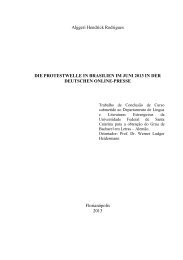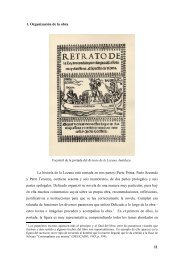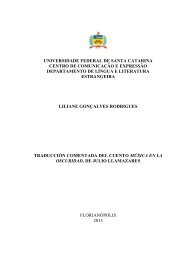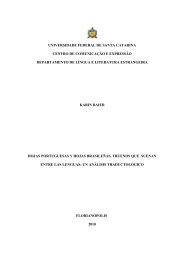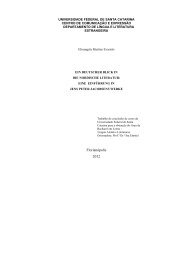TCC - Marcia Regina Barreto Moraes - Departamento de Língua e ...
TCC - Marcia Regina Barreto Moraes - Departamento de Língua e ...
TCC - Marcia Regina Barreto Moraes - Departamento de Língua e ...
You also want an ePaper? Increase the reach of your titles
YUMPU automatically turns print PDFs into web optimized ePapers that Google loves.
FINAL REMARKS<br />
First, this study presented fundamental basis for the literary analysis: poetry and<br />
prose concepts, and travel writing <strong>de</strong>finition. It was seen that travel writing accounts have<br />
remote origins: since the Greek and Roman antiquity. According to Mary Louise Pratt, in<br />
the late eighteenth century, travel literature became popular in Europe because of<br />
expansionism.<br />
James Clifford summarized travel as series of cultural practices and products, such<br />
as traditions, comportments, musics, books, among others.<br />
Related to the methodology applied, it consisted in a careful analysis. Not only<br />
travel writing elements were searched, but also literary analysis by means of dialogism was<br />
established consi<strong>de</strong>ring textual relations, historical and cultural contexts. Moreover, it was<br />
heedful of imagery as a creative aspect.<br />
Second, this study showed, in separated blocks, the singular aspects of Map of<br />
Dreams, The Tale of the Unknown Island and Maritime O<strong>de</strong>. Concerning Map of Dreams,<br />
it is suitable qualifying its set of poems as “a journey insi<strong>de</strong> an imaginary world that can be<br />
so real”, because in its <strong>de</strong>scriptions/images, there are references to other literary works and<br />
historical facts, like the allusion to Portugal and Spain during the Age of Discovery.<br />
In The Tale of the Unknown Island, it can be said that the man´s insistence on having a<br />
boat to find an unknown island has similarities to discoverers’ actions to find new lands.<br />
Maritime O<strong>de</strong>, in its turn, has the appearance of horror tale that brings to surface terrifying<br />
emotions and sensations of the speaker/navigator. This characteristic of the latter lends<br />
verisimilitu<strong>de</strong> to the story. The sadistic attitu<strong>de</strong> of the speaker/survivor is comparable to historical<br />
characters actions, as Vasco da Gama when he opened the first sea route to Asia.<br />
29



